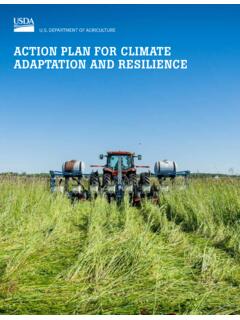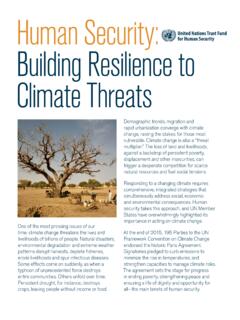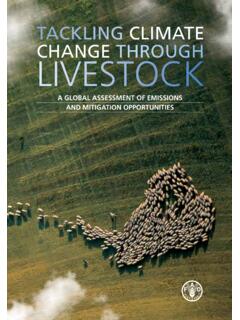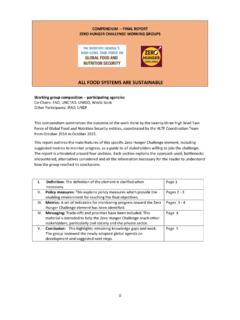Transcription of Regenerative Agriculture
1 1 Regenerative Agriculture Identifying the impact; enabling the potential Report for SYSTEMIQ School of Water, Energy and Environment 17 May 2019 Burgess PJ, Harris J, Graves AR, Deeks LK (2019) Regenerative Agriculture : Identifying the Impact; Enabling the Potential. Report for SYSTEMIQ. 17 May 2019. Bedfordshire, UK: Cranfield University. Photo on the front page is of an integrated crop, livestock and forest system in the Cerrado region of Brazil (Photo: Paul Burgess) 1 Regenerative Agriculture Burgess et al. (2019) Table of contents Executive Summary .. 3 1 Introduction .. 5 2 Definitions of Regenerative Agriculture .. 6 Introduction .. 6 Method .. 6 Regenerative Agriculture as a set of practices .. 6 Regenerative organic Agriculture .. 7 Regenerative Agriculture as farming that enhances.
2 8 Selected Regenerative Agriculture systems .. 9 Conclusions .. 10 3 Context for Regenerative Agriculture .. 12 Introduction .. 12 Linking land, food demand and production .. 12 Land use in 2000 .. 13 Land use from 1900 to 2000 .. 13 Land use from 2000 to 2050 .. 14 Carbon sequestration and greenhouse gas emissions .. 14 Biodiversity .. 15 Land sparing and land sharing .. 16 4 Impacts of Regenerative Agriculture systems .. 17 Introduction .. 17 Method .. 17 Results .. 18 Conservation Agriculture .. 18 Organic crop production .. 20 Tree crops .. 22 Tree-intercropping .. 23 Multistrata agroforestry and permaculture .. 24 Silvopasture .. 25 Multi-paddock grazing .. 25 Organic livestock systems .. 26 Rewilding and land abandonment from Agriculture .. 27 Conclusions.
3 28 5 Scaling of Regenerative Agriculture .. 30 Introduction .. 30 Estimates of current and potential areas .. 30 Conservation Agriculture .. 32 2 Regenerative Agriculture Burgess et al. (2019) Organic arable production .. 32 Tree crops .. 32 Tree intercropping, multistrata agroforestry and silvopasture .. 32 Multi-paddock and organic grazing .. 33 Rewilding and agricultural land abandonment .. 34 Conclusions .. 34 6 Enabling and promoting Regenerative Agriculture .. 35 Introduction .. 35 Recognising the role of Regenerative Agriculture in policy .. 35 Enabling farmers .. 37 Research and initiatives to improve Regenerative systems .. 38 Consumers and product premiums .. 39 Conclusions .. 39 7 References .. 40 8 Appendices .. 54 Appendix A: Papers identified in the Scopus database with Regenerative Agriculture in article, abstract or keywords.
4 54 Appendix B: Relating agricultural areas and yields to global demands .. 55 Appendix C: Worksheets of evidence .. 57 Appendix D: Calculation of the area of tree crops .. 67 3 Regenerative Agriculture Burgess et al. (2019) Executive Summary The current degradation of biodiversity and soil fertility has led to increasing calls internationally to reverse the direction of travel of global Agriculture from degenerative to Regenerative approaches. The definition of Regenerative Agriculture used in this report is a system of principles and practices that generates agricultural products, sequesters carbon, and enhances biodiversity at the farm scale . Important practices associated with Regenerative Agriculture are: 1) minimising or avoiding tillage, 2) eliminating bare soil, 3) encouraging plant diversity and 4) water percolation, and 5) integrating on-farm livestock and cropping operations.
5 Some systems also prioritise the minimisation of pesticides and synthetic fertilizers Regenerative organic Agriculture . The Regenerative systems examined in this report are conservation Agriculture ; organic crop production and grazing; tree crops; agroforestry including tree-intercropping, multistrata agroforestry and permaculture, and silvopastures; multi-paddock grazing systems, and rewilding. The purpose of the report is to identify the impact of these systems on food production , carbon sequestration and biodiversity enhancement, to determine their current extent, and to explain ways in which they can be scaled. The opportunities for Regenerative Agriculture occur in the global context of limited land, an increasing population and demand for food, and the need to reduce greenhouse gases and enhance biodiversity.
6 There is agreement that existing intact ecosystems of high biodiversity need to be protected from agricultural expansion. There is also agreement that reducing waste and constraining per capita consumption of animal products is desirable. Whilst some have contrasted land sparing and land sharing approaches, there is increasing agreement that enhancement of biodiversity will benefit from land sparing approaches at a range of scales. Each of the nine Regenerative Agriculture systems investigated can offer environmental benefits in terms of increased soil and above-ground carbon storage and/or enhanced on-farm biodiversity. Their effects on yield, revenue, and production costs depend on the baseline situation and the specific system. In many situations, conservation Agriculture can sustain yields and/or lead to reduced production costs.
7 Adding organic amendments to crops not receiving fertiliser can increase crop yields. Although certified organic production generally reduces crop and livestock yields compared to well-managed non-organic production , securing an organic premium typically results in greater profitability. The effects of agroforestry systems on food production are closely linked to the tree densities and whether the trees also provide feed and/or food. In some places, rewilding can be appropriate. Regenerative systems are already used on large areas and their extent is increasing. In Section 5, we estimate current global areas and annual rates of expansion of conservation Agriculture (180 Mha + 11 Mha/year), certified organic crop production (12 Mha + 1 Mha/year), certified organic grassland (48 Ma + Mha/year), tree crops (158 Mha + Mha/year), and agroforestry (324 Mha + Mha/year).
8 Assuming that 15% of the tree crop, grassland and organic crop systems are also agroforestry, these represent a current area of 689 Mha and a plausible area of 1426 Mha by 2050. The continued expansion of Regenerative Agriculture can be supported by actions at international, national and local scales involving policy makers, farmers, researchers, consumers and those 4 Regenerative Agriculture Burgess et al. (2019) involved in the food chain. Policy-led initiatives such as 4 per 1000 are important. Facilitating market- and consumer-driven processes such as continued expansion of certified organic Agriculture , which includes a consumer-derived price premium, is also necessary. The good news is that there are many Regenerative agricultural systems that are profitable, sequester carbon, and enhance biodiversity.
9 Globally such systems are becoming more widely adopted. 5 Regenerative Agriculture Burgess et al. (2019) 1 Introduction The United Nations Sustainable Development Goals (SDGs) provide a comprehensive framework to help decision makers and governments to balance social, economic and environmental challenges up to 2030 (United Nations, 2015). They include targets related to zero poverty (Goal 1), zero hunger (Goal 2), climate action (Goal 13) and life on land (Goal 15). The goals bring together individual sectoral goals such as the United Nations Framework Convention on climate change (UNFCCC), and the Convention on Biological Diversity and the Aichi Biodiversity Targets for 2011-2020. The increasing global demand for food can be met by agricultural expansion ( clearing forest land for crop production ) or intensification ( increasing yields from existing crop and grassland) (Tilman et al.)
10 2011). For the past 50 years, the dominant form of agricultural development has been intensification with low consideration of the environmental effects (Pretty et al. 2018). To counter this, sustainable intensification is promoted as an approach for increasing food production from existing farmland whilst placing less pressure on the environment and without undermining future production (Godfray and Garnett 2014). The approach is goal-, rather than means-orientated, with the most appropriate form of farming dependent on the context (Garnett et al. 2013). Recent studies continue to highlight the ongoing decline in global biodiversity ( IPBES 2018b; Sanchez-Bayo and Wyckhuys 2019). One approach has been to protect an increasing proportion of land for conservation (Mehrabi et al.






